Smile Design
When it comes to designing your new smile, we seek to create harmony with your facial features. Choosing a new smile is a very individual process; there are many variations of beautiful.
Due to the way our brains are hardwired, we habitually search for incongruity, for defects. This is called Defect Dominant Analysis and all humans tend to do this since we are pre-wired to evaluate beauty within faces. The human eye is trained to seek minute imperfections and to notice incongruence and disharmony first, whether it is crooked teeth or a broken, discoloured smile. Our objective will be to create a smile that harmonizes with your facial features.
The Esthetic Consultation
This consultation is a great opportunity to discuss your needs and expectations. We analyse your smile and help you through a self-evaluation to discover what you would like to see. We may show you some images on our computer and take photographs and impressions of your teeth.
Esthetic Imaging & Simulation: Now it’s time to create your new smile for you on a wax model and have professionally simulated before/ after pictures so you can evaluate the potential of the smile enhancement process clearly. Once we have fine- tuned everything to your liking we invite you to come in for the Esthetic Preparation appointment where we prepare the teeth and make impressions to send to our laboratory. Your next appointment is the Esthetic Finishing appointment. This appointment is to finalize your new smile.
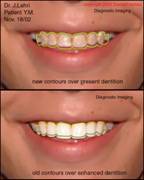
Proportions, Harmony and Balence
Here are just some of the elements that we evaluate when we analyze your smile:
The human brain perceives some forms as beautiful and others as unbalanced and less pleasant. This sense of beauty is hardwired in the human brain and is not learned. Newborns recognize their mother by facial proportions. Infants respond to beautiful forms. Very young children can identify attractive faces. Even across different ethnicities and cultures there is a common understanding of who is attractive. We now better understand the underlying mathematical and scientific basis of beauty. The first reference in western culture to the pleasure derived from mathematical proportions came from the Greek philosopher Pythagoras.
The first mathematical formula for beauty came from Italy in the 1495 from Fibonacci who described the “golden ratio” which is 1:1.618. This ratio is often designated by the Greek letter ‘phi’ and is used to create geometrical forms including the golden rectangle, golden triangle and the golden spiral (Nautilus shell).
In 1509, Pacioli published a dissertation De Divina Proporcione (divine proportions) that related these proportions to human form art and architecture. Leonardo DaVinci illustrated that dissertation. Subsequently, the art and architecture of DaVinci demonstrated the use of golden proportions and golden spirals, keeping elements in the 1:1.618 ratio of the “Golden Proportions” We use the same principles and proportions to create natural, balanced, harmonious smiles for you.
Facial Proportions
The smile should fit to the overall proportions of the face. We utilize a Dento-Facial Analyzer to get specific measurements of ideal tooth proportions by measuring the face.
This photo demonstrates a face divided into 3 equal horizontal thirds and two “halves” to assess symmetry.
We check that the smile is centered exactly with the midline of the face. We also try to ensure that the horizontal position of the smile should be parallel to the eyes (or the floor in someone with postural challenges).
The smile width should be the width of the distance between your pupils.

Smile Harmony
Maintaining harmony within a smile is essential so that everything blends in gracefully. We often accomplish this by looking at more than just one or two teeth and instead consider restoring multiple teeth to create change and transformation. Golden proportion plays an ideal role here.
Color
Whiter, brighter teeth are generally considered more youthful and attractive but at the same time we want to balance the use of subtle colours by looking at things like skin, gum and lip tone to create a natural smile that lights up your face yet still looks like you were born with it!
Lips and Lip Corridor
The lips “frame” your smile. Full, symmetrical lips set the stage for a terrific smile. We evaluate how many teeth you “display” when you smile and the “corridor” between your smile and lip-corners.
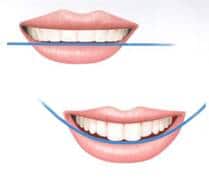
Smile Line
The smile line is formed by the bottom edge of the upper teeth. Ideally this line should follow the curvature of the lower lip. A straight flat smile line is less pleasing. A reverse curve where the front teeth appear to be shorter than the canines gives a look of aging and wear and can be quite unattractive.

Display, Height, & Width
The amount of upper and lower teeth that show in a smile is a key factor. You can have a high smile exposure, mid level or low smile exposure. Smiles are of varying widths. Generally, a wide smile is preferred and should be a width that corresponds to the distance between the pupils of your eyes.
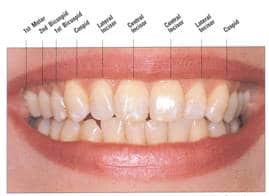

Gums & Embrasur
We examine the position, shape, colour and scalloping effect of your gum structure around the teeth. The gums should fill the space between teeth. Dark triangles of missing gum tissue can be unaesthetic. Similarly, the shape of the embrasures at chewing tip of the teeth can create visual appeal or disharmony.

Axal Incline (Straightness)
The midline and Central teeth should be symmetrical, the teeth lateral to them should have slight inclination and the canines should have an inclination from 5 to 33 degrees.
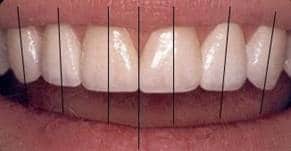
We Evaluate Old Fillings & Dental Work
Old fillings and dental work in the front teeth needs to be evaluated so that we are assured that the smile design is successful, strong and durable.
Light Refraction and Gloss
We evaluate tooth texture and surface characteristics to understand how your current and new smile will reflect and refract light. This enables us to further enhance aesthetic outcomes.
Tooth Size
The height to width ratio of the front teeth is also an important element in smile design. Symmetry is important and so is harmony with facial features.
Here are some smile design samples. The differences are minute and subtle – but can produce great results.

Tooth Shape
Tooth shape is a very important factor. Rounded edges can make smiles look feminine and straight edges can make the smile look masculine, whereas sharp edges can make a smile look youthful as you can see.
Here are some smile design samples. The differences are minute and subtle – but can produce great results.
Knowing you look your best provides a tremendous boost of self-confidence and reflects health, youth & vitality – and that’s a fact!
An attractive and inviting smile can make a tremendous difference in your personal and your professional life. Its no wonder they say “change your smile, change your life”.
Dr. Lehri has extensive training in esthetic dentistry and much experience with smile transformations. He is a ‘Smile Doctor’ who loves to make people smile.
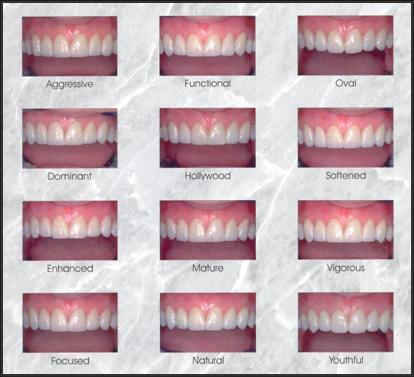











Designed and Developed by Identity Namebrands Inc.
Home | Meet the Doctors | Reviews | Our Office | Contact Us | Office Policies © 2009 Vaughan Smiles.
MAIN NAVIGATION
© 2009 Vaughan Smiles.